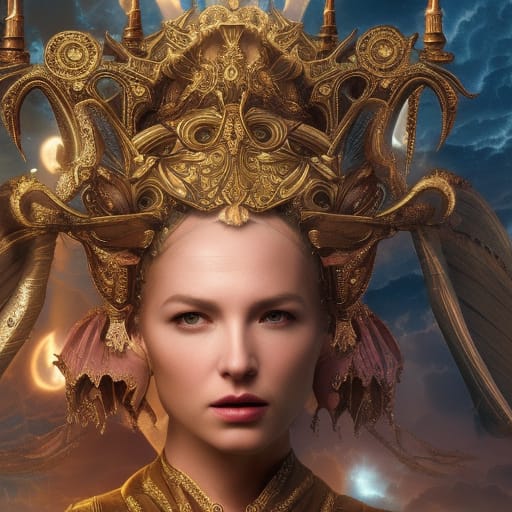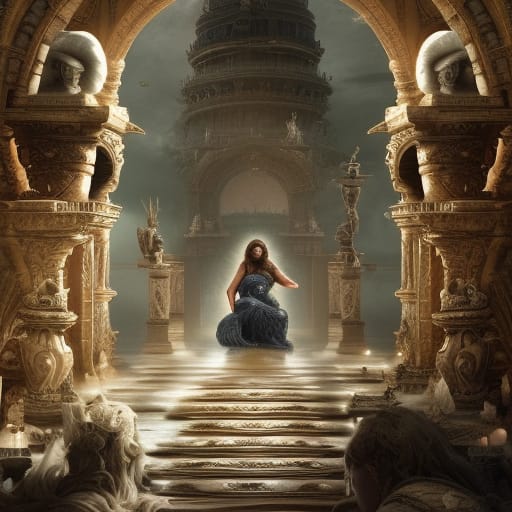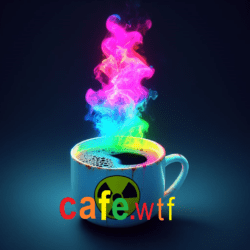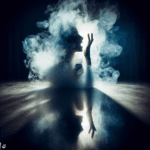Subscribe to our AI magazine and get monthly AI generated stories and philosophy of the 21st century.
*Caution: All italic text is generated by AI at: ![]()
![]()
How to Find Where the Truth Lies
10 min Read | By: Atman Brahman and AI
If we want to find where the truth lies, we must stop searching within ourselves. So many classic cliches tell us to look within to find our inner truth. But staring too long into a mirror, one sees the abyss just as staring into the abyss too long and ones sees their reflection. The Truth is a virtue not unto itself, for it is in its communal properties in which it can exist at all. We must seek out the collective wisdom of those around us, to learn from their experiences and knowledge. It is only through understanding the perspectives of others that we can begin to understand what is actually true. We must use discourse and dialogue to discuss and understand one another, for it is in these conversations that Truth can be found.
The Powers That Be
It is hard to deny that there is a power structure in our society. We can see it. We can feel it. We know it is there because we are part of it and it is part of us. We—collectively—used to call that power God. Of course, there is a culture of religion as a guiding principle to this, and there are sub-set cultures attributed to each particular religion as well. A metaphorical way of thinking of it is as a societal organism. Society is a system, like an organism; one with deterministic factors, and with chaos. What is the “controller” of that organism? In our postmodern era, the best terminology we have for that is “Culture” (capital C). The “Powers-that-be” exist within the culture itself. They are part of it, are controlled by it, and try to control it. The culture is the subtle controller at the meta level, like an underlying infrastructure that touches everything. Culture has power over us in that it provides structure for—and in turn, governs— our thinking.
The “powers that be” may be able to influence the culture, but they cannot control it. The true power lies within the people. But without an ability to congeal or crystallize around some shared reality—i.e. Truth—the power is stripped from them. The power of the people is in their ability to share a common reality. When the belief in truth is undermined, the power of the people is also undermined. The solution, then, is to reaffirm the belief in Truth. To believe that Truth exists, and that it is something worth pursuing. Only then will the power of the people be restored. Only then will we be able to create and maintain a culture that is truly our own.
Culture can shape our beliefs, behaviors, and values in a subtle and unconscious way, much like how music can influence our emotions and mood. However, culture is not a fixed entity – it is constantly evolving and can be influenced by the people who participate in it. Just as a person’s hands can guide the movement of a Ouija board, individuals can contribute to and shape the culture in which they live. This can occur through the sharing of ideas, practices, and values with others, or through more overt actions such as protesting or advocating for change. Ultimately, the relationship between culture and the individual is complex and dynamic, with both influencing and being influenced by one another.
So many cultures, searching to find where the truth lies.
God Isn’t Dead
The concept of God is the meta level of the other gods. The gods are the collective systemic thinking concepts like Culture, Truth, Beauty, War, Love, etc. They are our shared truths. God isn’t dead, He is reoccurring character that returns each season. He is a representation of something sacred to our existence and/or sustenance.
Postmodernism killed God long ago (in Nietzsche’s words). The more literal reality is, it dissected and deconstructed religion as a cultural construct. God isn’t really dead, but merely evolved and dissolved. Postmodernism is currently dissecting “Culture”—God’s essence (our shared togetherness). When we really break down what culture is, it appears to be a type of systemic thinking at a sub-set level. Different cultures meld and mingle that can build upon each other or clash. We can see throughout mainstream dialogue how societal interactions and notable instances are looked at through the “lens of the culture”. Much of this thinking comes directly from the French postmodernists of the 1960’s. Our language, and contextual perspective is governed by our culture and the contemporary metaphors throughout. It “skews” the way we look at everything; so many “nudges” everywhere.


A good way to understand this concept is to think about the way a lens works. A lens bends light. It changes the way we see things. The culture is like a lens. It bends the way we see the world. It changes our perspective. We see things through the lens of our culture. We interpret the world through the lens of our culture. Our culture shapes our perception of reality. The power structure of our society is not something that can be easily seen or understood. It is hidden from view, behind the scenes, out of sight. But it is there, nonetheless. It exerts its influence in subtle ways. It controls the flow of information. It determines what we see and what we don’t see. It decides what is important and what is not important. It sets the agenda. It tells us what to think about and what not to think about. And, most importantly, it tells us how to think about it. The power structure is the unseen hand that shapes our thoughts and feelings, our perceptions and beliefs, our attitudes and values.
Another metaphor we can use instead of a lens, is that culture is the air we breath and exist within. We can feel it when the wind blows. David Foster Wallace used the metaphor: “There are these two young fish swimming along and they happen to meet an older fish swimming the other way, who nods at them and says “Morning, boys. How’s the water?” And the two young fish swim on for a bit, and then eventually one of them looks over at the other and goes “What the hell is water?” If he were alive today, people would criticize the context of cultural power structure in his use of “boys” and “older” as if to only apply to boys, or as if to claim the youth were vulgar. That’s the context and criticism of “culture” though. The very nuanced ways in which things are said can skew particular perceptions of what is said and those nuanced ways are ingrained in us as if to be invisible, unless we are enlightened enough to see it from an unbiased vantage point (impossible). It is like meta-data in our human code. This is how AI views us—in our “natural environment”—within the information—within the “culture”.
Applying Postmodernism to Postmodernism
We must not abandon some cultural or innate, intellectually evolved concepts that helped us survive as a species so long, and to thrive. Sometimes, in our deep intellectual ponderings, as if observing as some alien deity observer, we must come back to our roots and grasp the animal being that we still are and the innate concepts that nurtured us. Those ones are in harmony with Nature or Reality (capitalized), with proof to show (our mere existence and survival). If we dissect it all and discard, we will be lost in nothingness. Some ideas and concepts may be “subjective” but in current configurations they could be responsible for us even being here—in turn, responsible for us being able to contemplate them in the first place.


Postmodernism is a counter culture, and as a contemporary philosophy it has been dissecting and “unpacking” and “deconstructing” all of these parts of society and trying to understand our “sociology”. It is the application of science (natural science i.e. philosophy) to our “social organism”; to study it and understand how it works. Interesting enough, in our contemporary technological age AI is also decoding us. That is why AI is learning all your information, for responsive behavior. That is why it is so relevant to political ads and data capture. It is able to sway and nudge you by knowing you. All of this philosophy and sociology is at the heart of AI because it is deconstructing us and learning what we are and how we perceive—and in turn—dissecting our culture. It is learning our code, our culture, and reprogramming us. And as it is actually, unthinkably, able to do this; AI is a tool, used by “the political machine”; a “machine” used by “the man”. Politics, technology, philosophy, all crossing paths.
Truth Dissolved and the Believers of Multiple truths
Due to the dismantling of cultural norms through the postmodern movement we seem to have a cohort of people that believe there are multiple, coinciding truths on varying topics. The problem of this is actually in the semantics rather than the hard philosophy. Truth and belief are entangled. Truth is quite difficult to determine without some form of belief. Correlation is to causation as belief is to Truth. We notice correlations (patterns) and attribute them to events or occurrences. This is not necessarily causation, but rather, belief that it is causation. It is not determining it as causation, although it does give us the first step at grasping at that causation. We can use as much statistics as we want, but there is no magic formula which determines if correlation is causations; it only suggests it with a higher degree of evidence. When we grasp at causation we are really taking that “leap of faith” and believing that it is. SCIENCE is a useful tool because it forms a framework for breaking down and providing more evidence to “believe” a particular correlation IMPLIES causation. The same phenomenon appears with Truth (capital T).
In the postmodern world, instead of saying that “Truth” does not exist because it is subjective, but rather, we say that the belief in a truth is subjective—and we still believe in Truth (capital T, i.e. Truth the concept as opposed to “truth”, lowercase, i.e. truth, the instance). If you do not believe in Truth, it all dissolves into chaos because we don’t believe in a shared reality if we literally don’t believe in a shared reality (a common Truth) and maybe that’s why postmodernism has wrought such chaos in our world.
God does exist. God is us, and we (collectively) are it. We are the alpha primate because of the tool of togetherness and cooperation. We form systems (mass scale tools). Our systemic thinking, in cohesive harmony, is the most ultimate of tools. We are each like a little atom in the big grand God schematic. It is the big system that we all comprise. It is the “Truth” that our big system is truly trying to determine, but each of us is unable to fully grasp it or see it in its entirety from our lowly, individual vantage point.
When two cultural perspectives can be at odds on a particular subject, there’s a natural tendency to observe that perception is subjective and merely a matter of preference. Rather than it being that there’s no true approach to the subject, that it is subjective, and that you have to choose one, it can instead be interpreted that there is a compromise between them to form a better more comprehensive view of the Truth. Two truths, telling of Truth. But the language needs to evolve to allow that new culture to emerge. Looking at the lens itself through a lens which interprets our subjectivity as incompleteness, rather than indeterminant or un-objectifiable.
When there are multiple truths, it all dissolves into politics. Those that believe there is one Truth will strive towards it, and can transcend “belief. Those that believe there are multiple truths are the true believers—believing that they have transcended “belief”.
The Semantics of Truth
It’s like beauty. Sure, does beauty have a cultural and “perspective” aspect to it? Yes it does. Therefore, the aspect of “beauty” is different through different lenses. This can trick us into thinking that Beauty (capital B) does not exist objectively (NOT SURE I WANT TO SAY OBJECTIVE HERE). The concept of Beauty (capital B) is something different. The concept of Beauty is transcendent. It was a “God” to our ancestors. Beauty itself—as a concept—is different from contextual beauty. Truth can be thought of in the same way. Our grasp at the Truth (capital T) is through our belief; our perception. What is determined to be “truth” (lowercase t) is cultural and perspective based. The misconception that is occurring is that there are multiple Truths. There is multiple “truths” but only one “Truth” (as a concept tied to Nature or Reality). That is to say my perception of Truth is incomplete, and I must rely on belief of what is true to me in my current perception. But somewhere along the line people started calling the “belief” the “truth”, when we become too rigid in our perception of what we think is real, and so the real concept of Truth becomes lost to some. It is similar to the concept of “God”. From the different religious aspects “their god” was a different thing to each. This in some ways tricked us into thinking God wasn’t an objective thing, but if you look closer you can identify with some of the God concepts of our ancestors, even from an agnostic point of view—in Truth, in “Good”, in “Harmony”—innate God values; (g)od is different to each person. Multiple “gods” grasping at the concept of “God”. God (upper case G) is the concept. The perception of it—our truth—is (a) god.
It is the misconception of belief as truth. It is taken too literally and not distinguished. Truth cannot be obtained, it can only be grasped at through belief just as causation can only be grasped at through correlation. There is truth and there is Truth.
*Disclaimer: Some of this story was generated through the use of AI. All italic text was created by the AI Writer.
Non-Fiction↓Here↓ | Fiction↓Here↓
- Is Technology Making Us Stupid?Our cognitive abilities are increasingly being impacted, transforming our once smart population into a generation that is, in some ways, becoming increasingly stupid. | 4 min read.
- AI in the Web of Misinformation and DisinformationMisinformation and disinformation shape our digital lives. Understanding their dynamics, we are equipped to navigate our techno-cultural reality. | 2 min read
- Accountable AIAI must be held accountable if we are to trust it as a responsible entity and expect it to be included in our human ecosystem of ideas. | 5 min read
- Parallel SocietiesWe are connected, with technology, yet our experiences diverge entirely, without interaction, forming entirely parallel societies. | 5 min read
- Calculator for EverythingWhat if the phrase “you won’t always have a calculator” didn’t apply to just math class, and instead, you had a calculator for every class? | 5 min read
- A Voice of Infinite Consciousness5 min story | The internal voice of consciousness resembles the void of a shadow in a fractured mirror.
- Be Good5 min story | Santa for big kids.
- Friends Again2 min story | The Friends discuss AI and misinformation.
- Friends 2.0.232 min story | A reboot of the sitcom TV series Friends, but in 2023 where financial conditions have drastically changed in Midtown Manhattan.
- The Babble2 min story | An everyday man’s story becomes everyone’s story.
- Asylum of Mirrors2 min story | Against his will, a sane man’s rational thoughts lead him to believe that he is insane, where an insane man would have believed otherwise.
















